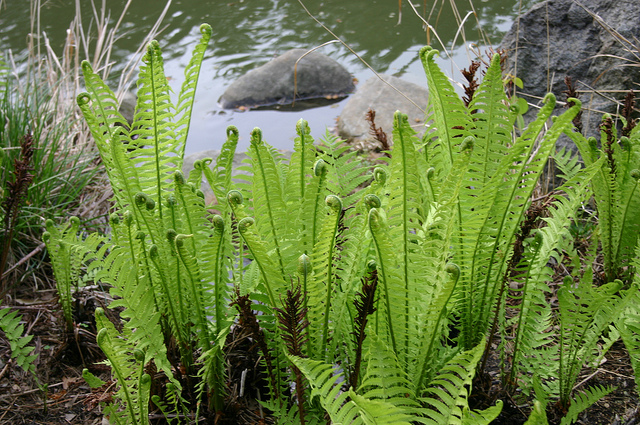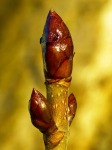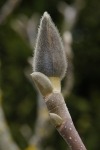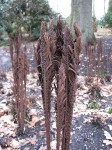 Family: Onocleaceae
Family: Onocleaceae
Genus: Matteuccia
Species: Matteuccia struthiopteris
Common names: ostrich fern, fiddlehead ferns or shuttlecock fern
Swedish name: strutbräken
Matteuccia struthiopteris is said to be the only species in the genus Matteuccia. Depending on how it is classified some include M. orientalis and M. intermedia (both Asian species). The name struthiopteris is derived from the shape of the sterile fronds where struthio meaning ostrich and pterion meaning wing. The ostrich fern is a popular ornamental plant in gardens. The sprouts are edible and picked all over Japan (where it is called kogomi). The immature fronds, called fiddleheads, are also used as a cooked vegetable.

Matteuccia struthiopteris. Photo: Ryan Somma ©
Description: Matteuccia struthiopteris is a perennial, deciduous and robust fern with creeping rhizomes. The bright green fronds (leaves) are sterile instead its sporangia is placed on stolons, brownish fertile fronds. The plant forms colonies of erect rosettes to 1.5m in height with the green fronds surrounding the fertile fronds. The sporangia and stolons are developed in autumn, staying erect over the winter and release the spores in early spring. This feature gives it a decoration value in winter. Matteuccia struthiopteris is otherwise most beautiful in spring when the large, pale green, fronds start to unfurl and filter the sunlight. Later the green fronds droop and disappear which should be taken into account. It is useful for very wet sites.
How to grow: Matteuccia struthiopteris prefers moist and shade to half shade. It needs to be sheltered to remain its beauty over the season. It is a great woodland plant and a nice ground cover under shrubs or trees. Remove dead fronds in early spring. Propagate by sowing spores as soon as ripe or by division in spring. Low maintenance.
Seasonal value – beauty all year
When we are to purchase new plants we often start to look in catalogs, garden books or browse for plants online. Most plants are just represented with a picture of the flowers leaving foliage, buds or other values behind. We need to learn to study all the characteristics and take every season into consideration. I will give you some examples and then I challenge you to look for more plants with seasonal value. Look at different bark/stems, twigs, buds, seed pods, stolons, grass (grains), bloom and foliage.

Chestnut bud

Magnolia bud

Himalayan birch stem/bark.

Cherry stem/bark.

Ostrich fern stolons
© The photo is licensed by Creative Commons and some rights are reserved. License Attribution 2.0


I have wondered what the edible fern tastes like…
LikeLike
I haven´t tasted them myself yet. But from what I have heard they are delicious.
LikeLiked by 1 person
I love ferns. This is a great post. You have given very good advice about proper study prior to purchasing plants. I never buy plants online- i prefer to go see and touch the plant before i get it home…
LikeLike
Thank you! I am like you – I always want to look at the rootsystem and health of the plant. I only buy seeds and bulbs online chosing companies I trust.
LikeLike
I’m going to see if it will grow in my region/area. Sounds lovely and I always appreciate plants/flowers that have a pleasant scent. Lisa, co-host AtoZ 2015, @ http://www.lisabuiecollard.com
LikeLike
I hope it will grow in your garden. It is so lovely!
LikeLike
I once shot a wedding that had fiddlehead ferns as the primary decor element.. it was STUNNING! Simply beautiful bouquet! ❤ – http://www.domesticgeekgirl.com
LikeLiked by 1 person
I bet it was lovely! Ferns should be used more. I like the fresh green color and the shape of the leaves 🙂
LikeLike
Didn’t know that one. Sometimes just the plain bright green plants are so vibrant and beautiful:-)
LikeLiked by 1 person
We have some ferns on our property … judging from your winter picture, I’m reasonably sure that they aren’t ostrich. They do, however, produce fiddle heads and I’m wondering, are all fiddle heads on all ferns edible? I love the idea of watching plants to see the changes during the seasons. Some plants have such subtle changes that, unless we’re really looking, we’ll miss them.
LikeLike
My guess is that not all fiddleheads are edible. But I have to look it up. To be certain I would make sure what spieces I had so no mistakes were made… I agree with you, every season has its beauty and it is easy to miss the changes…
LikeLiked by 1 person
Yes, I’ll take your advice. I will say that, around here, I’ve never seen them available at farmer’s markets or our local produce stand and people, around here, are very big on foraging so I think that if they were edible, I’d probably being seeing them for sale. Thanks, Charlotte!
LikeLiked by 1 person
A wise conclusion! I would love to learn more about foraging…
LikeLiked by 1 person
I love the way ferns unroll as they grow. I can see a bit of it in the photo. Instinctively, I wouldn’t have eaten this plant.
LikeLiked by 1 person
That is a good instinct. There are many poisonous plants and you have to be sure what is edible or not. Some are just too beautiful to eat…
LikeLike